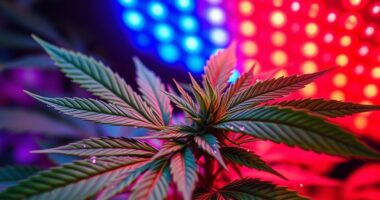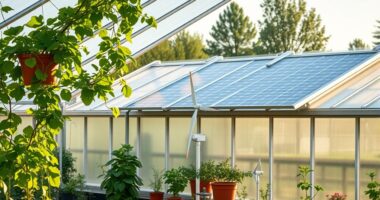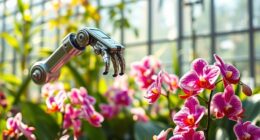By integrating aquaponics into your greenhouse, you create a sustainable environment where fish and plants thrive together. You’ll combine water, nutrients, and space efficiently while reducing waste. Proper system design, fish selection, and water management are key to maintaining healthy aquatic life and lush plants. Regular monitoring and system care help prevent issues like disease or stress. Keep exploring to discover how to optimize this harmonious, productive setup further.
Key Takeaways
- Select suitable fish species based on climate, tank size, and water parameters for optimal harmony.
- Design the system with reliable filtration, proper water flow, and aeration to maintain water quality.
- Regularly monitor and adjust water parameters like pH, ammonia, and nitrates to ensure fish and plant health.
- Incorporate sustainable practices to reduce waste, maximize space, and promote a balanced ecosystem.
- Prioritize ongoing maintenance and system optimization for long-term stability and productive greenhouse operation.

Integrating aquaponics into your greenhouse offers a sustainable way to grow fresh vegetables and fish simultaneously. This method creates a symbiotic environment where plants and aquatic animals thrive together, reducing waste and maximizing space. To succeed, you need to pay close attention to fish health, as healthy fish are essential for maintaining nutrient levels and ensuring the system runs smoothly. Fish health depends on factors like water quality, temperature, oxygen levels, and proper feeding. Regular monitoring and prompt action when issues arise keep your fish vigorous and productive. When considering your system design, it’s vital to create a setup that supports ideal fish health while allowing efficient water circulation and plant growth. A well-designed system minimizes risks of disease, pollution, and stress for your aquatic life.
Your system’s design should include a reliable filtration mechanism to keep water clean and oxygen-rich, which directly impacts fish health. Incorporate biological filters that foster beneficial bacteria, which convert fish waste into nutrients usable by plants. The placement of fish tanks should be accessible for maintenance, with aeration systems to ensure a steady supply of oxygen. This not only supports fish health but also enhances overall system stability. The flow of water between fish tanks and grow beds must be carefully calibrated to prevent overcrowding and maintain proper nutrient distribution. An ideal design balances water volume, flow rate, and filtration capacity, creating a resilient ecosystem. It’s also wise to include a backup plan, like a generator or additional filtration, to prevent system failure during power outages or equipment malfunctions.
Furthermore, your fish species choice influences system design and fish health management. Select species suited to your climate, tank size, and water parameters, and learn their specific needs. Regular water testing for pH, ammonia, nitrites, and nitrates helps you catch potential issues early. Keeping water parameters within acceptable ranges minimizes stress and disease in your fish, promoting overall health. Integrating aquaponics isn’t just about placing fish and plants together; it’s about designing a harmonized system that prioritizes fish health through thoughtful planning and continuous care. Proper system design ensures that your aquatic animals remain healthy, your plants flourish, and the entire operation remains sustainable and productive. When you focus on these elements, you’ll create a thriving, balanced aquaponic environment that benefits both your garden and aquatic life.
Frequently Asked Questions
What Are the Initial Costs of Setting up an Aquaponics System?
When considering the initial costs of setting up an aquaponics system, you should do a thorough cost analysis and budget planning. Expect expenses for tanks, grow beds, plumbing, and equipment, which can range from a few hundred to several thousand dollars depending on system size. Factor in fish stock and plants, too. Proper planning helps you manage costs and avoid surprises, ensuring your aquaponics setup is financially sustainable from the start.
How Do I Choose the Best Fish and Plant Combinations?
When choosing the best fish and plant combinations, focus on fish selection and plant pairing that thrive together. Opt for fish like tilapia or goldfish, which are hardy and easy to care for. Pair them with nutrient-loving plants such as lettuce, herbs, or tomatoes. Consider your climate and system size to guarantee compatibility. By selecting the right fish and pairing them with suitable plants, you’ll create a balanced, productive aquaponics system.
What Are Common Pests and Diseases in Aquaponics Systems?
You might worry about pests and diseases disrupting your aquaponics system, but with proper pest management and disease prevention, you can keep everything healthy. Common pests include aphids and snails, while diseases like fungal infections can occur. Regular monitoring, maintaining water quality, and using natural predators help protect your fish and plants. Implementing these strategies guarantees your system remains productive and balanced, making pest and disease control manageable.
How Often Should I Test Water Quality Parameters?
You should test water quality parameters regularly to maintain a healthy system. Water testing frequency depends on your setup, but generally, you should check weekly for parameters like pH, ammonia, nitrite, and nitrate. Ideal testing intervals ensure you catch issues early. Adjust testing frequency if you notice changes in fish behavior or plant health, or after system disturbances, to keep everything in balance and prevent problems.
Can Aquaponics Be Scaled for Commercial Farming?
Think of aquaponics as a seed that can grow into a thriving commercial farm. Yes, it can be scaled for commercial farming, especially in urban farming settings where space is limited. This system supports sustainable practices by conserving water and reducing waste. With proper planning, you can expand your aquaponics operation to meet market demands, making it a viable, eco-friendly solution in the domain of large-scale agriculture.
Conclusion
By integrating aquaponics into your greenhouse, you create a thriving ecosystem where fish and plants support each other like a well-choreographed dance. Imagine the first time you saw your tomatoes flourish alongside your fish swimming happily — it’s like witnessing nature’s perfect harmony in action. With just a little effort, you can turn your greenhouse into a sustainable oasis, proving that when you combine innovation with care, growth truly knows no bounds.









